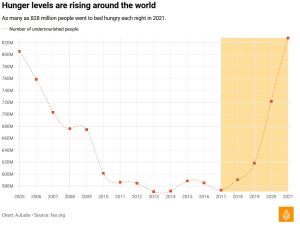Industrial Agriculture: Difference between revisions
Florez4747 (talk | contribs) (→Soy) |
Florez4747 (talk | contribs) |
||
| Line 87: | Line 87: | ||
See: [[Bayer-Monsanto]] | [[Syngenta]] | See: [[Bayer-Monsanto]] | [[Syngenta]] | ||
The pesticide industry is valued to be | The pesticide industry is valued to be over 60 billion dollars.<Ref>https://sentientmedia.org/factory-farmings-toxic-relationship-with-the-pesticide-industry/</Ref> | ||
In 2018, a report<Ref>https://dkt6rvnu67rqj.cloudfront.net/sites/default/files/media/WAP_Collateral_Damage_Report_02_04_22_R3.pdf</Ref> indicated, approximately 235 million pounds of pesticides were used to grow crops for farmed animals in the so-called United States.<Ref>https://sentientmedia.org/factory-farmings-toxic-relationship-with-the-pesticide-industry/</Ref> | In 2018, a report<Ref>https://dkt6rvnu67rqj.cloudfront.net/sites/default/files/media/WAP_Collateral_Damage_Report_02_04_22_R3.pdf</Ref> indicated, approximately 235 million pounds of pesticides were used to grow crops for farmed animals in the so-called United States.<Ref>https://sentientmedia.org/factory-farmings-toxic-relationship-with-the-pesticide-industry/</Ref> | ||
Revision as of 22:21, 28 June 2023
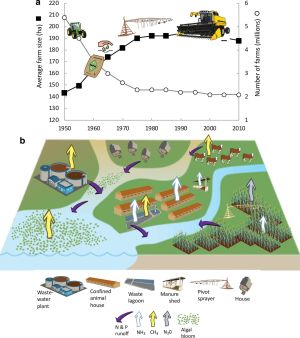
Industrial agriculture is a system of uniformity with no diversity: massive acres of land covered in identical nearly artificial plants; fed artificial nitrogen, potassium, and phosphorus; sprayed with toxic pesticides, insecticides and herbicides. In Who Really Feeds The World, Dr. Vandana Shiva explains how “an ecologically destructive and nutritionally inefficient food system has become the dominant paradigm in our minds and the most touted practice on our lands, even though, in reality, small, biodiverse farms working with nature’s processes produce most of the food we eat.”
Indigenous Persons across Turtle Island have long utilized place-based regenerative agriculture techniques. Placed-based regenerative agriculture is predicated around the reality of humans being but one part in the web of life, and understanding our role as stewards to the environment.
Fully comprehending our stewardship role on Earth is vital to reversing the destructive effects of industrialized society and agriculture. Anything short of fully embracing this role (which we all must fulfill) will have long lasting devastating effects for us, future generations, and all other life on Earth.[2]
Mono-Cultures
The US Farm Bill, the major legislation that encompasses agriculture, conservation, and research and food assistance programs, has, over its various iterations and re-authorizations, incentivized monoculture production, primarily corn and soybean. Its major objective is to stabilize prices and incomes, not to protect environmental interests. This massively expensive legislation guides all aspects of the US food and farming systems, but is heavily influenced by special interests, and thus its policies have favored consolidated large-scale farms, and grains over fruits and vegetables, heavy use of chemical fertilizers, among other incentives to maximize profits over environmental stewardship.[3]
Because of these shifts and other policy- or economic-related factors, most of the grain grown in US is not used directly for food. It is fed to animals in feedlots (about 36%), used for biofuels (about 40%), exported (about 10%), and used in high-fructose corn syrup and other food products (a few %; Foley 2013; Barton and Clark 2014). Of the total acreage in corn, about 5%, or 2 million ha, is needed just to support the supply of chicken and pork sold at McDonalds and Walmart. Only ~ 1% of all corn grown is directly eaten by people as “sweet corn”. The mandate for ethanol production in the US, originally intended to support farmers and reduce foreign dependence on oil, has resulted in 12.5 million ha of corn dedicated to ethanol corn (equivalent to more than all the crop land in Iowa) and likely has contributed to an increase in N fertilizer use in the past 2 decades. In the 1990s, the US produced about 10 million MT of corn for biofuels; in 2018 it was ~ 140 million MT, about 12-fold more than that used for high fructose corn syrup.[4]
Corn
Soy
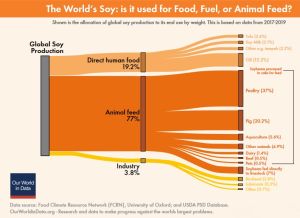
Hunger
Industrial Agriculture produces massive amounts of mono-cultured food stocks, but there are still millions of people across the globe who go hungry everyday or die from starvation. According to the 'Food Security Information Network' in 2022 258 million people across 58 countries/ territories faced high levels of acute food insecurity which was an increase from the 193 million people in 2021.[7]
Because not all countries were included in these studies the number of people who go hungry is much higher; Between 702 and 828 million people go hungry every day according to the 2022 'State of Food Security and Nutrition in the World' report published by a joint collaboration under the United Nations.[8] World hunger rose further in 2021 after the emergence of the COVID-19 Pandemic:
... After remaining relatively unchanged since 2015, the prevalence of undernourishment (PoU) jumped from 8.0 to 9.3 percent from 2019 to 2020 and rose at a slower pace in 2021 to 9.8 percent.
It is estimated that between 702 and 828 million people were affected by hunger in 2021. The number has grown by about 150 million since the outbreak of the COVID-19 pandemic – 103 million more people between 2019 and 2020 and 46 million more in 2021, considering the middle of the projected range.
The further increase in global hunger in 2021 reflects exacerbated inequalities across and within countries due to an unequal pattern of economic recovery among countries and unrecovered income losses among those most affected by the COVID-19 pandemic, all in a context of diminishing social protection measures that had been implemented in 2020.[9]
Even more people were moderately or severely food insecure in 2021 with the number reaching 2.3 billion or nearly 30 percent of the global population, which is 350 million more people than 2019 or before the COVID-19 Pandemic began.[10]
Gender Inequality
The gender gap in food insecurity – which had grown in 2020 under the shadow of the COVID-19 pandemic – widened even further in 2021, driven largely by the widening differences in Latin America and the Caribbean, as well as in Asia. In 2021, the gap reached 4.3 percentage points, with 31.9 percent of women in the world being moderately or severely food insecure compared to 27.6 percent of men.[11]
Solutions
See: Food Sovereignty | Agroecology | Just Transition
CAFOS

CAFOS are 'Confined Animal Feeding Operations' and have increased, in the US, by 10% between 2012 and 2020. Hog production increased by 13 percent during the same time frame. There are ~8.7 billion animals in CAFO operations- animals include: Cattle, Dairy Cows, Hogs, Broiler Chickens, and Turkeys. The areas where animals are farmed is concentrated regionally across the country.[13]
The waste from hog and dairy operations is mainly held in open lagoons that contribute to NH3 and greenhouse gas (as CH4 and N2O) emissions. Emissions of NH3 from animal waste in 2019 were estimated at > 4,500,000 MT. Emissions of CH4 from manure management increased 66% from 1990 to 2017 (that from dairy increased 134%, cattle 9.6%, hogs 29% and poultry 3%), while those of N2O increased 34% over the same time period (dairy 15%, cattle 46%, hogs 58%, and poultry 14%).[14]
The numbers of animals in CAFOs differs widely, depending on the animal and regional permitting. CAFOs are categorized as small, medium, or large depending on the number and type of animal and the drainage system for their waste. Small CAFOs (those with small animal populations just under the definition of medium-sized) are often undercounted or un-permitted and are expanding in many regions where regulations apply only to larger facilities. By keeping animal operations to numbers that do not fall into the category for regulation, operators maintain more options—and more polluting options—for handling waste. Current permitting and legal differences between states makes it difficult to obtain an accurate count of the number of CAFOs in the US. Transparency of CAFO data, with respect to permit state, location, manure storage or type, and number of animals is low for almost every state; the US Environmental Protection Agency (US EPA) does not have such data for about half of the CAFOs in its inventory of 2012. New algorithms are being applied to obtain better estimates and these approaches suggest that the number of CAFOs is actually more than 15% higher that which is routinely reported from manual enumerations.[15]
Over 70 billion land animals are raised for factory farms across the world with approximately 10 billion being raised in the US alone.[16]
Artificial Fertilizers
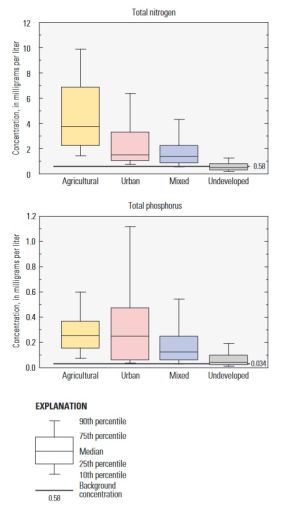
Commercial artificial fertilizers are ubiquitously used across the so-called United States- with nitrogen (N) exceeding 12 million metric tonnes (MT) and is increasing annually at a rate of 60 thousand MT per year. Phosphorus (P) has remained constant for the last decade being used at a rate of 1.8 million MT per year.[18] Nitrogen applied by fertilizer is about 3 times greater than manure Nitrogen inputs and manure Phosphorus inputs are about equivalent to artificial Phosphorus inputs.[19] Around 38% of all applied N to crops in the so-called united states is lost as environmental pollution contributing to Hypoxia in the Gulf of Mexico (41 percent of all N found in this dead zone is from the midwest,) and other watersheds.[20]
The possibility of mitigating the industrial corn-soy system’s loss of synthetic N fertilizer via within-system technological solutions is frequently promoted. However, reflecting the inherent, system-level flaws with an agricultural system based on synthetic N use, the potential of technologies to mitigate contributions to water pollution and N loss to the environmental overall are limited, with studies finding little to no reduction in agricultural N loss to waterways from their use. After their analysis of the impact of technological approaches in reducing N loss to waterway from midwestern corn-soy farms, Blesh and Drinkwater summarize: “Our results suggest that the dominant manage ment emphasis on adjusting the timing and placement of [synthetic] N inputs (i.e. within-system approaches) has biogeochemical limitations in terms of the degree to which N retention can be increased.” In other words, it is increasingly clear that significantly mitigating the issue of N water pollution requires agroecological approaches and eventual system transformation toward a much more ecological diverse approach to agriculture.[21]
Dead Zones
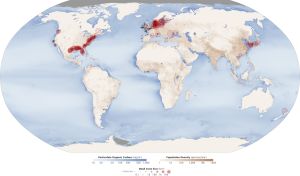
"'Dead zone' is a more common term for hypoxia, which refers to a reduced level of oxygen in the water. ... Less oxygen dissolved in the water is often referred to as a “dead zone” because most marine life either dies, or, if they are mobile such as fish, leave the area. Habitats that would normally be teeming with life become, essentially, biological deserts. "[23]
The negative effects of hypoxia include loss of suitable and required habitat for many bottom-dwelling fishes and benthic fauna, habitat compression for pelagic fishes, direct mortality, increased predation, decreased food resources, altered trophic energy transfer, altered bioenergetics (physiological, development, growth, and reproductive abnormalities) and altered migration. These result in reduced fisheries, including valuable finfishes and crustaceans. Increasing nutrient loads that also change the nutrient ratios can affect the composition of the phytoplankton community and can shift trophic interactions. Hypoxia also alters or interrupts ecosystem functions and services such as nutrient cycling and bioturbation.[24]
Dead zones across the world increase with humanity's growing dependency on chemical fertilizers for crops. Additionally, Global climate collapse has a high likelihood of worsening existing hypoxia zones and facilitating its formation in additional waters.[25] In 1995 there were 195 documented areas of human-caused hypoxia and by 2008 Diaz and Rosenberg[26] documented over 400 cases of hypoxia in the world's coastal ocean which covered more than 245,000 km2 of sea bottom.[27]
The corn-belt (mainly encompassing Illinois, Indiana, Iowa, Missouri, and Ohio) of the so-called United States uses more than 4.5 million metric tonnes (MT) of chemically manufactured Nitrogen and uses more than one million MT of manure produced Nitrogen. The Nitrogen is mainly used to fertilize soy bean and corn crops and is considered to be the main source of Nitrogen causing the Gulf of Mexico dead zone.[28][29]
Additional Reading:
https://www.sciencedirect.com/science/article/abs/pii/S2212613914000373?via%3Dihub
https://academic.oup.com/icesjms/article/66/7/1528/656749
Pesticides and Insecticides
See: Bayer-Monsanto | Syngenta
The pesticide industry is valued to be over 60 billion dollars.[30] In 2018, a report[31] indicated, approximately 235 million pounds of pesticides were used to grow crops for farmed animals in the so-called United States.[32]
Climate Collapse
Land-Use Change
An enormous portion of our agricultural lands, roughly one-third, are used for mass-producing corn and soy, the vast majority of which is not for human consumption. Globally, roughly 67 – 77% of soy produced is used as feed for livestock , and 36 - 45% of the corn produced in the US is used as feed.
Not only are our existing agricultural lands heavily used to produce just these two crops, but worse, wildlands are continuing to be converted to cropland in order to grow more.
From 2018-2019 alone an estimated 2.6 million acres of grasslands in the US were plowed up and converted to row crop agriculture, with 70% of this conversion occurring for just three crops: corn (25%), soy (22%) and wheat (21%). For soy in particular, the “conversion of important grasslands and conservation lands to soybean production is one of the biggest issues” facing high conservation value native vegetation in the US. The massive scale of soy or corn cropping systems leads to loss of biodiversity and threatens thousands of endangered and threatened species. Foxes and bats, migratory birds, bumblebees, and prairie butterflies, are all imperiled by grassland conversion and industrial agriculture.
High levels of meat consumption are driving the decline in wild animal populations via the ever-increasing intensification of monoculture feed crop cultivation to feed the farmed animals raised in the factory farming systems that produce the majority of meat consumed in the US today.[33]
Water Usage
70 percent of the world's water is used for agriculture and 40 percent of this water is lost to the environment due to evaporation, poor irrigation systems and poor water management. Livestock requires 30 percent of the 70 percent of water to produce feed for the animals, water for drinking, and hygiene. One cow used for producing milk uses about 40 to 50 gallons of water a day.[34]
Colorado River
The Colorado River supplies water for 40 million Americans and is in a state of crisis do to over use. Roughly 1.9 trillion gallons of water are consumed within the Colorado River basin in a year. Of the almost 2 trillion gallons of water consumed 79 percent of it is utilized for agricultural purposes. 55 percent of the 79 percent of water is used to produce Livestock feed (Alfalfa, Hay, Grasses, and Corn Silage.) 11 percent of the 79 percent is used to produce Cotton, 3 percent is used for Wheat, 2 percent is used for Corn grain, 1 percent for Barley, and 7 percent for other crops.[35]
See a graph illustrating the usage of water here: https://www.nytimes.com/interactive/2023/05/22/climate/colorado-river-water.html
To put it in perspective, it could take more than 38 gallons of water, by some estimates, to produce one quarter-pound beef patty. That includes the water to grow all the feed like alfalfa and hay that the cattle themselves eat. In comparison, you need about five gallons of water to get the same amount of protein from tofu. Dairy products like milk and cheese are even more water-intensive per gram of protein than beef because dairy cows require more energy to produce milk. They’re often fed alfalfa, in part because it’s higher in calories and protein. Some tree nuts like almonds can use a relatively large amount of water as well.[36]
Alfalfa
Thirty-seven percent of the water used in the Colorado River basin goes toward growing alfalfa and hay used largely to feed dairy cattle. That’s triple the water that residents in the region use to water lawns, take showers and wash clothes. Alfalfa is a thirsty crop, in part because of its lengthy growing season that allows for multiple harvests per year. It’s an export, too. Researchers estimated in the 2020 study that 10 to 12 percent of the irrigated cattle-feed crops grown in the United States are exported, and about 10 percent of beef is exported.[37]
Corporations
See: Bayer-Monsanto | Syngenta | General Mills | Silicon Ranch Corporation
... should food production and distribution be centrally controlled by giant, globe-spanning business enterprises? They advertise that they can more efficiently “feed a hungry world,” but have no direct relationships to local lands or communities. They operate according to a hierarchy of values that places institutional profits above all other concerns. Their program is to convert millions of acres that once grew a great diversity of locally developed food crops into vast monocultures, fed by pesticides and chemical fertilizers, and requiring oil-guzzling machinery, commercial seeds, et. al. Food is then transported across continents and oceans, often destined for luxury markets within already well-fed countries. These giant corporate interests like to argue that their production methods and distribution systems are the only way to successfully grow food for the world. That has been their continuing advertising theme, hawked through billions of dollars in persuasive television and print commercials year after year. And over the past several decades, they have succeeded in shifting a high percentage of food production toward large industrialized globalized systems, run by ever larger, and ever fewer giant corporations...[38]
Alternatives
See: Food Sovereignty | Free Breakfast For Children | Agroecology | Permaculture
Small Farm Food Production
Around 70% of the world is fed by small-scale farmers and other peasants.[39] The International Fund for Agricultural Development (IFAD) estimated that small producers provide 80% of food in large parts of the developing world. [40] A paper published by the UN Food and Agriculture Organisation (FAO) in 2021 made the claim that small farms only feed about one third of the world’s population.[41] In response:
Eight organisations with long experience working on food and farming issues, including ETC Group and GRAIN, have now written to FAO Director General QU Dongyu, sharply criticizing the UN food agency for spreading confusing data. The open letter calls upon FAO to examine its methodology, clarify itself and to reaffirm that peasants (including small farmers, artisanal fishers, pastoralists, hunters and gatherers, and urban producers) not only provide more food with fewer resources but are the primary source of nourishment for at least 70% of the world population.[42]
Dr.Vandana Shiva speaks on the myth of small farms and small scale-farmers having lower rates of production:
We have seen, small, biodiverse farms are more ecologically efficient than large industrial monocultures. When one recognizes that small farms across the world produce greater and more diverse outputs of nutritious crops, it becomes clear that industrial breeding has actually reduced food security. Industrial farming has created hunger and poverty; yet large industrial farms are justified as necessary in order to produce more food....
...Small farms produce more food than large industrial farms because small-scale farmers give more care to the soil, plants, and animals, and they intensify biodiversity, not external chemical inputs. As farms increase in size, they replace labor with fossil fuels for farm machinery, the caring work of farmers with toxic chemicals, and the intelligence of nature and farmers with careless technologies.
...What is growing on large farms is not food; it is commodities. For example, only 10 percent of the corn and soy taking over world agriculture is eaten. Ninety percent goes to drive cars as biofuel, or to feed animals being tortured in factory farms.[43]
Barriers to Transition
In a study conducted by Houser et el[44] 154 farmers were interviewed about industrial agriculture's contribution to Nitrogen polluting watersheds. The majority of the farmers interviewed either believed that the issue of Nitrogen leakage was over blown or that market mechanisms (read capitalism) either prevent the over use of Nitrogen or that it would eventually lower the amount of Nitrogen used on crops.
... we find that many farmers believe there is a problem with water pollution, yet the cause or nature of the problem is not perceived as related to farmers’ actions or their responsibility. Ideologies that focus on the role of urban polluters (agrarianism), conceal the significant role of agricultural N loss. In terms of the best way of solving N pollution, farmers largely believed that technological changes could reduce pollution (techno-optimism). While some suggested that markets had already or were the best way to solve problems (market-fundamentalism), none pro- posed an increase in fertilizer price or a fertilizer tax as a solution—although this solution has been effective where adopted—nor did they consider other policies that would at least encourage a reduction in total N use. Solutions proposed do not represent a significant transition towards ecological practices but justify maintaining the current system.[45]
The few farmers who acknowledged that industrial agriculture is the primary source of Nitrogen pollution had a hard time imagining another system outside of the dominant status quo:
The limited number of farmers who felt like system-change was necessary to address industrial agriculture’s contributions to N loss often concluded their statements with comments indicating their uncertainty of what the actual change could be (13 of the 154 farmers). As one respondent stated, “Well I think, the [nutrient] erosion situation needs to be addressed.[…] the corn-soybean rotation is not the best way […]. But I’m…not quite sure what the answer [is]”. Similarly, the inability to see another type of system, a more wholistic society, and agrarian system, is illustrated by another comment from the above linear-system farmer, who felt that this is the only form an agricultural system can take: “As long as we bury people in cemeteries, as long as we have septic tanks and public sewer systems and all of those things we will never have sustainable agriculture. It’s impossible!”. Lastly, one respondent explained that to address environmental problems the only solution is to “quit farming. Which isn’t going to happen, people need to eat”. Even when problems are acknowledged, there was no recognition of alternative ways to produce food with less pollution. Farmers overlook that another system is possible, one where society-environment relations are remodeled in a way to enable a more fully incorporated and regenerative agriculture system.[46]
Belief in no alternative
...we can see how these ideological positions serve to prevent social transformation and maintain the current system, a finding that reflects prior work examining the role of agrarian ideologies as forces of social reproduction in the face of environmental changes (Dentzman 2018). In our case, a widespread belief that another way to produce food, with far less pollution, is not possible prevents farmers from engaging in transformative projects, be it agricultural or political. Whether large corporations selling seed, fertilizer, and other key components to the industrial system are propagating narratives that “there is no alternative” is beyond the scope of this paper, but others have identified that seed and fertilizer companies use information, marketing strategies and personal contact with farmers to encourage the use of their products, as well as the belief that “high yield” is the ultimate production goal, despite evidence of persistently low prices due to over-production. Given this evidence, it can be reasonably suggested that input giants strategically promote industrial and technological pathways that preserve the current system and at the same time ignore or refute the possibility of transformation toward an agroecological system. Regardless of the role of input companies, we find that farmers adopt ideological positions that rationalize their role in the current system and serve to maintain this system and fail to envision or consider agroecological alternatives that may more effectively reduce environmental degradation.[47]
Tackling the Barriers
Just Transition | Food Sovereignty | Climate Revolution | The Red Nation
A lack of belief that another system is possible represents a considerable barrier to transforming the agricultural system to address environmental impacts. As Therborn (1980) explains, if one cannot see that there is a real possibility for change it will not occur. While technological fixes can reduce nitrogen loss, nitrogen loss is a system issue and agro-ecological transition is required to adequately address it. Given our findings, increasing awareness about agroecological practices and visions and policies for an agroecological system is a paramount first step in supporting efforts toward pursuing this transition.[48]
... we recognize agroecological practices do not shift every dimension of the current agri-food system. The productivist values that are foundational to the industrial system can accord with and even justify the adoption of agroecological approaches, as has been shown with other “sustainable” approaches to agriculture (Guthman 2004; Jaffee and Howard 2010). Relatedly, agro-ecological transformation of the industrial agriculture system will not address other key flaws in the global agro-food system, such as the unequal distribution of food, power, and profits. Addressing these issues likely requires more widespread efforts to reform (or replace) the broader political economy of capitalist production in which the food system is embedded. Our findings suggest that it is unlikely many US row-crop farmers are interested in calling for these more radical transformations yet. But, given the accelerating economic and environmental contradictions of industrial agriculture, farmers’ critique of not only the industrial method of production but the structural economic context it is embedded within, may emerge more forcefully. Future studies should build on our analysis by examining if these dynamics are giving rise to farmers’ interest in more transformative critiques of and visions for the agro-food system.[49]
Sources
- ↑ Glibert, P.M. From hogs to HABs: impacts of industrial farming in the US on nitrogen and phosphorus and greenhouse gas pollution. Biogeochemistry 150, 139–180 (2020). https://doi.org/10.1007/s10533-020-00691-6
- ↑ https://branchoutnow.org/growing-sovereignty-turtle-island-and-the-future-of-food/
- ↑ Glibert, P.M. From hogs to HABs: impacts of industrial farming in the US on nitrogen and phosphorus and greenhouse gas pollution. Biogeochemistry 150, 139–180 (2020). https://doi.org/10.1007/s10533-020-00691-6
- ↑ Glibert, P.M. From hogs to HABs: impacts of industrial farming in the US on nitrogen and phosphorus and greenhouse gas pollution. Biogeochemistry 150, 139–180 (2020). https://doi.org/10.1007/s10533-020-00691-6
- ↑ https://dkt6rvnu67rqj.cloudfront.net/sites/default/files/media/WAP_Collateral_Damage_Report_02_04_22_R3.pdf
- ↑ https://www.aljazeera.com/news/2023/5/28/why-is-global-hunger-on-the-rise-2
- ↑ FSIN and Global Network Against Food Crises. 2023. GRFC 2023. Rome.; https://www.fsinplatform.org/sites/default/files/resources/files/GRFC2023-hi-res.pdf
- ↑ FAO, IFAD, UNICEF, WFP and WHO. 2022. The State of Food Security and Nutrition in the World 2022. Repurposing food and agricultural policies to make healthy diets more affordable. Rome, FAO. https://doi.org/10.4060/cc0639en
- ↑ FAO, IFAD, UNICEF, WFP and WHO. 2022. The State of Food Security and Nutrition in the World 2022. Repurposing food and agricultural policies to make healthy diets more affordable. Rome, FAO. https://doi.org/10.4060/cc0639en
- ↑ FAO, IFAD, UNICEF, WFP and WHO. 2022. The State of Food Security and Nutrition in the World 2022. Repurposing food and agricultural policies to make healthy diets more affordable. Rome, FAO. https://doi.org/10.4060/cc0639en
- ↑ FAO, IFAD, UNICEF, WFP and WHO. 2022. The State of Food Security and Nutrition in the World 2022. Repurposing food and agricultural policies to make healthy diets more affordable. Rome, FAO. https://doi.org/10.4060/cc0639en
- ↑ https://reports.worldanimalprotection.org/US/Pesticides#5
- ↑ Glibert, P.M. From hogs to HABs: impacts of industrial farming in the US on nitrogen and phosphorus and greenhouse gas pollution. Biogeochemistry 150, 139–180 (2020). https://doi.org/10.1007/s10533-020-00691-6
- ↑ Glibert, P.M. From hogs to HABs: impacts of industrial farming in the US on nitrogen and phosphorus and greenhouse gas pollution. Biogeochemistry 150, 139–180 (2020). https://doi.org/10.1007/s10533-020-00691-6
- ↑ Glibert, P.M. From hogs to HABs: impacts of industrial farming in the US on nitrogen and phosphorus and greenhouse gas pollution. Biogeochemistry 150, 139–180 (2020). https://doi.org/10.1007/s10533-020-00691-6
- ↑ https://dkt6rvnu67rqj.cloudfront.net/sites/default/files/media/WAP_Collateral_Damage_Report_02_04_22_R3.pdf
- ↑ https://pubs.usgs.gov/circ/1350/pdf/circ1350.pdf
- ↑ Glibert, P.M. From hogs to HABs: impacts of industrial farming in the US on nitrogen and phosphorus and greenhouse gas pollution. Biogeochemistry 150, 139–180 (2020). https://doi.org/10.1007/s10533-020-00691-6
- ↑ Glibert, P.M. From hogs to HABs: impacts of industrial farming in the US on nitrogen and phosphorus and greenhouse gas pollution. Biogeochemistry 150, 139–180 (2020). https://doi.org/10.1007/s10533-020-00691-6
- ↑ Houser, M., Gunderson, R., Stuart, D., & Denny, R. C. H. (2020). How farmers “repair” the industrial agricultural system. Agriculture and Human Values, 37(4), 983–997. doi:10.1007/s10460-020-10030-y
- ↑ Houser, M., Gunderson, R., Stuart, D., & Denny, R. C. H. (2020). How farmers “repair” the industrial agricultural system. Agriculture and Human Values, 37(4), 983–997. doi:10.1007/s10460-020-10030-y
- ↑ https://earthobservatory.nasa.gov/images/44677/aquatic-dead-zones
- ↑ https://oceanservice.noaa.gov/facts/deadzone.html
- ↑ Rabalais, N. N., Díaz, R. J., Levin, L. A., Turner, R. E., Gilbert, D., and Zhang, J.: Dynamics and distribution of natural and human-caused hypoxia, Biogeosciences, 7, 585–619, https://doi.org/10.5194/bg-7-585-2010, 2010.
- ↑ Rabalais, N. N., Díaz, R. J., Levin, L. A., Turner, R. E., Gilbert, D., and Zhang, J.: Dynamics and distribution of natural and human-caused hypoxia, Biogeosciences, 7, 585–619, https://doi.org/10.5194/bg-7-585-2010, 2010.
- ↑ Robert J. Diaz Rutger Rosenberg, Spreading Dead Zones and Consequences for Marine Ecosystems. Science321,926-929(2008).DOI:10.1126/science.1156401
- ↑ Rabalais, N. N., Díaz, R. J., Levin, L. A., Turner, R. E., Gilbert, D., and Zhang, J.: Dynamics and distribution of natural and human-caused hypoxia, Biogeosciences, 7, 585–619, https://doi.org/10.5194/bg-7-585-2010, 2010.
- ↑ Glibert, P.M. From hogs to HABs: impacts of industrial farming in the US on nitrogen and phosphorus and greenhouse gas pollution. Biogeochemistry 150, 139–180 (2020). https://doi.org/10.1007/s10533-020-00691-6
- ↑ Turner, R. E., Rabalais, N. N., & Justic, D. (2006). Predicting summer hypoxia in the northern Gulf of Mexico: Riverine N, P, and Si loading. Marine Pollution Bulletin, 52(2), 139–148. doi:10.1016/j.marpolbul.2005.08.012
- ↑ https://sentientmedia.org/factory-farmings-toxic-relationship-with-the-pesticide-industry/
- ↑ https://dkt6rvnu67rqj.cloudfront.net/sites/default/files/media/WAP_Collateral_Damage_Report_02_04_22_R3.pdf
- ↑ https://sentientmedia.org/factory-farmings-toxic-relationship-with-the-pesticide-industry/
- ↑ https://dkt6rvnu67rqj.cloudfront.net/sites/default/files/media/WAP_Collateral_Damage_Report_02_04_22_R3.pdf
- ↑ https://htt.io/water-usage-in-the-agricultural-industry/
- ↑ https://www.nytimes.com/interactive/2023/05/22/climate/colorado-river-water.html
- ↑ https://www.nytimes.com/interactive/2023/05/22/climate/colorado-river-water.html
- ↑ https://www.nytimes.com/interactive/2023/05/22/climate/colorado-river-water.html
- ↑ http://www.meadowviewfarmandgarden.com/resources/The%20Rise%20and%20Predictable%20Fall%20of%20Globalized%20Industrial%20Agriculture.pdf
- ↑ https://www.globalagriculture.org/whats-new/news/en/34543.html
- ↑ https://www.ifad.org/en/crops
- ↑ https://www.fao.org/family-farming/detail/en/c/1398060/
- ↑ https://www.globalagriculture.org/whats-new/news/en/34543.html
- ↑ Dr. Vandana Shiva, 'Who Really Feeds the World:The Failures of Agribusiness and the Promise of Agroecology Page:56&60
- ↑ Houser, M., Gunderson, R., Stuart, D., & Denny, R. C. H. (2020). How farmers “repair” the industrial agricultural system. Agriculture and Human Values, 37(4), 983–997. doi:10.1007/s10460-020-10030-y
- ↑ Houser, M., Gunderson, R., Stuart, D., & Denny, R. C. H. (2020). How farmers “repair” the industrial agricultural system. Agriculture and Human Values, 37(4), 983–997. doi:10.1007/s10460-020-10030-y
- ↑ Houser, M., Gunderson, R., Stuart, D., & Denny, R. C. H. (2020). How farmers “repair” the industrial agricultural system. Agriculture and Human Values, 37(4), 983–997. doi:10.1007/s10460-020-10030-y
- ↑ Houser, M., Gunderson, R., Stuart, D., & Denny, R. C. H. (2020). How farmers “repair” the industrial agricultural system. Agriculture and Human Values, 37(4), 983–997. doi:10.1007/s10460-020-10030-y
- ↑ Houser, M., Gunderson, R., Stuart, D., & Denny, R. C. H. (2020). How farmers “repair” the industrial agricultural system. Agriculture and Human Values, 37(4), 983–997. doi:10.1007/s10460-020-10030-y
- ↑ Houser, M., Gunderson, R., Stuart, D., & Denny, R. C. H. (2020). How farmers “repair” the industrial agricultural system. Agriculture and Human Values, 37(4), 983–997. doi:10.1007/s10460-020-10030-y
